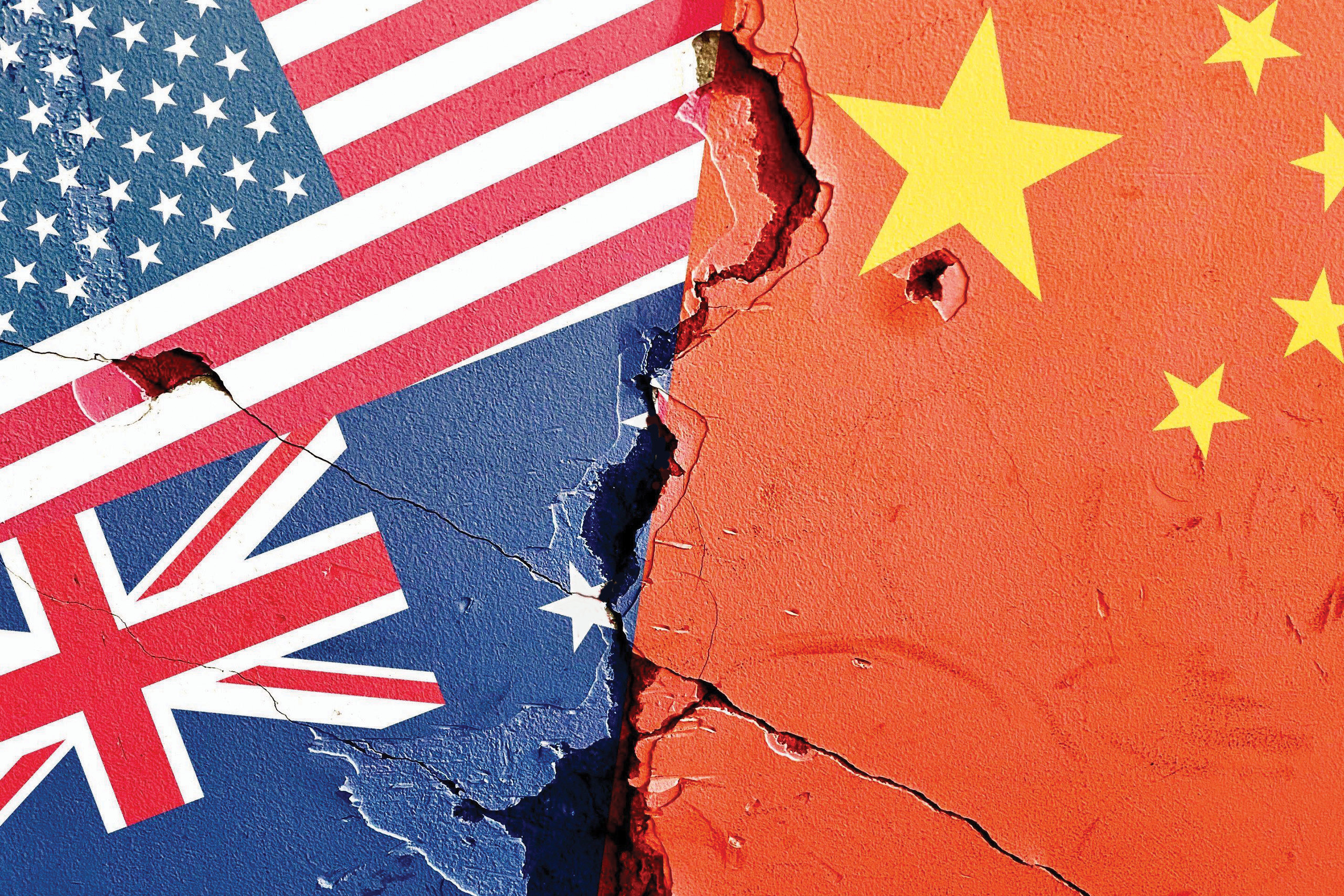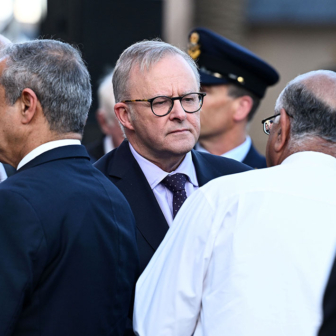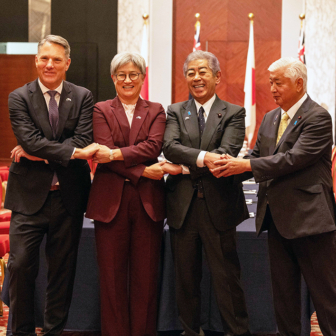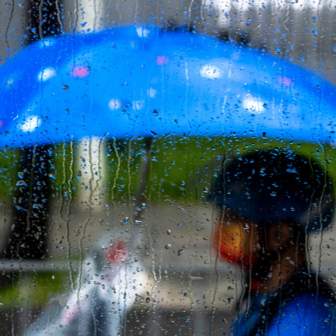In his new book, We Should Be So Lucky, investment banker and arts patron Andrew Low asserts outright what most Australians think but can’t be bothered to say: Australia is a pretty good place, and better than most. It has, he points out, the highest median per-capita wealth in the world. Its economy is bigger than Spain’s or South Korea’s. Australians have great healthcare and reasonably good education. Despite having a far more diverse ethnic mix than most other countries, Australia has few of the racial tensions seen elsewhere. And while it is often said that Australian wealth is just the luck of mineral resources and distance from trouble, Low reminds us it is also the product of good institutions, including an inherited British legal framework, compulsory voting and a preferential ballot, and a social culture that balances individualism and egalitarianism, openness to the rest of the world and hard work.
Written and published before Trump’s “Liberation Day,” We Should Be So Lucky captures Australia at what may prove to be the acme of a particular trajectory, a point at which the balance between the United States as a security ally and China as the major economic partner was reconcilable, when being an exemplar of how to succeed in the global economy was self-evidently a very satisfactory ambition. With America smashing its own model, with Beijing and Washington at odds over the future of the global economy, with even the British government declaring that globalisation is dead, are the foundations Low describes quite as firm? Our easy circumstances, our generous self-appraisal, need some further thought.
But first, Low’s Australia. Like the successful business executive he is, Low thinks it is good to be sceptical, to judge success in material and measurable terms such as the quality of healthcare, education opportunity, wealth and income. He dislikes caste, rank, deference, grandeur and greatness, religious fervour, reverence for tradition, grand objectives, manifest destiny, and so forth. In these respects he is like most Australians. He celebrates what we have: not as a paradise on earth but as a reasonable way to live. Australians mightn’t be spiritually elevated, but they have a sensible outlook on life.
All of which makes Australia, for Low, just about the best place in the world to live. Using John Rawls’s test, if an imaginary person could choose a country to live in but not the circumstances in which he or she would find themselves in that country, Australia would be the best choice.
A pretty good place, but so what? To a British audience, at which this book is partly aimed, this is a call for major reform. The UK could do with compulsory and preferential voting, Low thinks, a healthcare system more like Australia’s, a defined-contribution superannuation system like Australia’s, a skills-based immigration system like Australia’s and a more open class system like Australia’s. If you want to do well in the modern global economy, be more like us!
For British readers, it is an argument for radical change. For Australian readers, not so much. We are smug enough already without being reminded of how fortunate we are. Low suggests Australians don’t realise how good a place it is, with the implication that his book is a useful corrective. I am not sure this trope is right, at least for most Australians. Far more people come to Australia permanently than leave it permanently. “It makes you realise,” Australians travelling abroad whisper to each other, looking dubiously at extreme poverty, extreme wealth, unsatisfactory beaches, “how well off we are.” It is certainly true that many young Australians want to live overseas for a while if they can. Most will later return. After thirty-four years of robust economic expansion — Covid excepted — we are less greedy for reassurance that Australia is a desirable place to be.
Sometimes Low trips, but not often and not badly. Prime minister John Curtin’s wartime call to America came well before the Japanese air raid on Darwin, not after. More problematic is his preferred summary measure of the superior well-being of Australians. He chooses median wealth per person, an indicator on which Australia is tops. But this is mostly a measure of the value of our housing stock, which is far and away the biggest component of wealth for Australian families. It’s a good thing that two-thirds of families own their homes but what this indicator really means is that the price of residential land in Australia is high compared to other wealthy countries. This is arguably more a measure of failure than success. We would be better off with cheaper land, lower house prices, and a lower ranking on that particular measure. For that to happen we need better urban transport and fewer constraints on increasing the housing stock in places where people want to live. Though they are implicitly his preferred measure of Australian success, Low elsewhere in the book complains of high house prices.
Even so, Low’s point that Australians are materially well off today is right. GDP per capita is less than the United States but well above Germany, France, Britain and New Zealand (measured by the World Bank, in 2015 constant US dollars). It may not be as well spread as many Australians like to think, but income inequality is constrained. Using OECD Gini coefficient measures, Australian household income (after tax and social security benefits) is more evenly spread than household income in the United States, Britain, Japan Korea and New Zealand, though less evenly than household income in Canada, France, Germany or Scandinavia.
Andrew Low’s model for We Should Be So Lucky is Donald Horne’s The Lucky Country, published in 1964. He follows Horne’s organisation and frequently references Horne’s book. Yet the books are sixty years apart and Low’s book is about a very different Australia from Horne’s, so I am not convinced the analogy works.
For Horne, Australia was a lucky country run by second-rate people who shared its luck. He was writing during a splendid postwar boom that saw faster GDP growth and a faster rise in living standards than we have seen since. In 1964 wool still accounted for almost half of Australia’s exports and Britain was still Australia’s biggest export market. TV penetration was high but it would be another seven years before the first Jumbo jet joined the Qantas fleet, thirteen years before the first Apple PC, a quarter century before the internet reached Australia and twenty-eight years before the first smartphone, all innovations which have vastly increased Australian connectedness with the rest of the world. It was two years before the Holt government formally abandoned the White Australian Policy and nearly a decade before it was abandoned in practice. Per capita income in constant Australian dollars was a third of today’s level. Since The Lucky Country Australia has changed and the world has changed, mostly for the better. Like Keith Hancock’s 1930 Australia, The Lucky Country is an excellent book about Australia as it once was, but has not been for quite a while.
Low argues that Australia’s success is built on an inherited British structure of common law rights, parliaments and the beginnings of political democracy. But he also accepts a popular narrative that prior to the Hawke and Keating governments Australia underperformed its peers and lost its nineteenth-century claim to have a standard of living superior to most of the rest of the world. These two narratives sit side by side uneasily. The same institutions produced success, then failure, then success again. Evidently the institutions cannot be the whole explanation.
An account that better fits the facts is that of the late Ian McLean, who in Why Australia Prospered argued that the early policies of wage arbitration, industry protection and emphatically British-only migration were consistent with a high degree of comparative economic success. Australia recovered from the Great Depression faster than the United States, for example, and continued to outperform Britain. That comparative success was obscured by the rapid growth of Western Europe and Japan’s shattered economies after 1945, and then by the acceleration of export-oriented growth in North Asia and Southeast Asia copying the Japanese example. By the time the Hawke and Keating governments came along the earlier and for a long while successful model was well and truly exhausted, and sharply challenged by the growth of manufacturing in Asia. The revolution Hawke and Keating led was timely.
Low suggests towards the end of his book that things today are not quite right, though there is still time for Australia to “recover its mojo” through a “methodical program of continuous improvement.” Otherwise governments will continue “backsliding” into the bad old ways of the 1970s and earlier. Yet it is not at all clear what Low’s program is. He urges us to pay more attention to the Productivity Commission, to encourage Indigenous Australians to own their own homes, to do something about what he claims are declining education standards. But he doesn’t specify what PC recommendations may make a difference, or discuss the strengths of weaknesses of existing programs to help Indigenous people own their own homes on Indigenous land, or examine the competing views about whether school standards are declining or staying much the same.
As an expatriate Australian he was perhaps peeved by travel restrictions during Covid. He sharply criticises the Australian response, which he puts down to an Australian preference for a nanny state. But he doesn’t acknowledge countries with fewer restrictions had many more deaths. (Excess deaths per 100,000 people, the standard approximation of Covid-related fatalities in the period, were more than four times higher in the United States and three times higher in Britain — countries with far fewer Covid restrictions — than in Australia. In 2020–22 Norway imposed the strictest controls in Europe, while neighbouring Sweden’s controls were among the lightest; Sweden’s population is twice that of Norway but excess deaths there during the period were twenty-two times higher.)
Low likely finished writing before Donald Trump’s re-election and so doesn’t have to ask what we do in this wonderful and prosperous place, a country both lucky and well organised, pragmatic and improvisational, populated by nice, well-cared-for and well-educated people, when its major security ally and global best friend suddenly goes rogue.
The economic consequences may be manageable. Unlike Mexico or Canada or China or Europe or Japan or Korea, Australia exports relatively little to the United States. It sells ten times as much to China, four times as much to Japan, and markedly more to each of Korea, India and Taiwan than to the United States. All up, Australian exports to the United States are around 1 per cent of Australian GDP, and usually less than American exports to Australia. American business investment in Australia is quite big, true, but there are plenty of sources of business investment in the world, including Australia itself (and China, shunned in recent years). These days Australia owns considerably more in foreign businesses than foreign businesses own in Australia. In 2023 Australia owned more business equity in the United States than the US in Australia.
Even so, Australia is more influenced than most by big tides in the global economy. Compared to GDP it exports far more than the US, and more than China or Japan. If the major economies are in trouble so is Australia, and all the more so if China is particularly hard hit. Yet the present crisis is almost entirely focused on exports to the United States rather than trade between the remaining 194 countries in the world. It is not a global economic crisis or even a global trade crisis. While the United States does indeed account for a quarter of world GDP, its size and self-sufficiency mean it accounts for only one-tenth of global imports. Roughly speaking, nine-tenths of global trade is unaffected by US tariffs.
The crisis is mutating into a trade conflict between China and the United States. Trade between the two will likely fall markedly. But China is less dependent on the US economy than widely believed. If China’s exports to the US were cut in half — a very severe but possible outcome — and only half of those lost exports were redirected elsewhere, China’s growth rate would be pegged back by something like one percentage point, maybe two. Significant, but not a great shock to the rest of the world, or even to Australia. After all, China’s annual growth rate has varied by far more than two percentage points over the past ten or fifteen years, with no significant impact on Australia.
The big loser from US tariffs and the response to them from US trade partners is the US. Americans will pay more for their shopping basket. Its leading businesses have been among the biggest beneficiaries of global supply chains and open trade, and will be the biggest losers as the US hobbles imports and provokes restrictions on its exports.
What does matter to Australia is the US defence connexion. Yet, as Sam Roggeveen, Hugh White and James Curran remind us, Australia’s biggest security asset is not the defence alliance with the United States, such as it is, but the vast physical distance between Australia and any credible threat. Leaning inward, American security assurances are now more conjectural. For Australia, the appropriate defence response is surely more self-reliance, and with it a clearer understanding of exactly what threats we need to prepare against. That, as Roggeveen argues, means dropping the AUKUS program, which only makes sense if Australia is assisting US operations against China. Replacing it with a larger fleet of smaller submarines might be less useful for distant allied operations but more useful for defending Australia.
It may well be the most important consequence of “Liberation Day” for Australia is a change in the nature of the national debate. For a decade or more Australian thinking about the world has been dominated by increasing fear of China, and its counterpart of increasing adherence to American foreign and defence policy. Part of that shift has been the increasing influence of the intelligence agencies over both the Treasury and the Department of Foreign Affairs and Trade. With the abrupt and likely enduring shift in attitudes in the US administration, the Australian proponents of adherence to US objectives have found the ground collapsing under them. The position of those whose authority in Australia depends on talking to Washington will give way to those with a broader view in contact with other capitals, and economic officials who know numbers.
As Low writes, Australia is not compelled to follow the American lead any more than it is compelled to follow a Chinese lead. Though he may not have had this crisis in mind, they are wise words. Australians may not be good long-term planners, he observes, but they are good improvisers. Being adaptable, Low thinks, is better than being visionary. Adaptable is what we need to be. •
We Should Be So Lucky: Why the Australian Way Works
By Andrew Low | Prospect Editions | $51.99 | 308 pages




